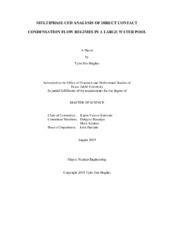| dc.description.abstract | This work considers the Pressure Suppression Chamber, a component of the Reactor Core Isolation Cooling System that is instrumental in maintaining core cooling capabilities during conditions such as the station blackout that occurred at Fukushima Daiichi. In previous experimental work at the NHTS Suppression Chamber facility, bulk pool temperature stratification was assessed during long term transients consistent with conditions at Fukushima. In this work, short-term mixing behavior in a BWR Suppression Chamber system is assessed using computational fluid dynamics. In this work, direct contact condensation was modeled within STAR-CCM+ utilizing experimental conditions from Test Case #4 at the NHTS Suppression Chamber experimental facility. The Eulerian multiphase segregated flow model with the 2D axisymmetric formulation was employed. The steam-water condensation interaction was modelled utilizing the Hughes-Duffey Nusselt number correlation. The phase interface saturation temperature was treated as variable and was computed through the use of built in IAPWS steam tables within STARCCM+. Simulations were completed for an initial steam bubble formation and deformation phase within the Suppression Pool, accounting for a 48 ms overall transient.
It was found that the dynamics of steam bubble formation and deformation process most closely mirrors the bubbling direct contact condensation flow regime which was observed experimentally at the simulation initial conditions. However, the reason for the presence of this flow regime in the simulation was found to be attributable to an insufficient rate of condensation with the achieved condensation rate of 45.3 g/s only slightly exceeding the inlet steam mass flow rate to the Sparger of 45 g/s. The formation of a hot spot near the Suppression Chamber Sparger outlet likely caused this flow regime to be observed experimentally. This led to the conclusion that better spatial resolution of the water temperature obtained from thermocouples near the Sparger outlet at the NHTS Suppression Pool facility would allow for a more realistic setting of initial conditions for future simulations of this kind. Also, based on the rapid pressure changes observed from the simulation presented in this work, an increase in measurement frequency of pressure instrumentation to at least 500 Hz was also recommended. | en |


